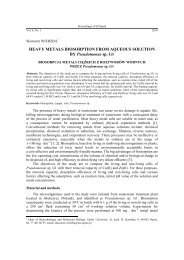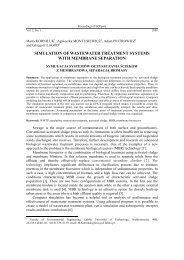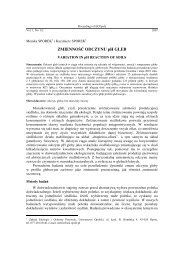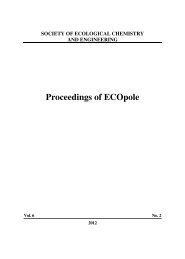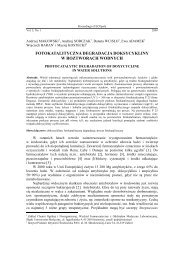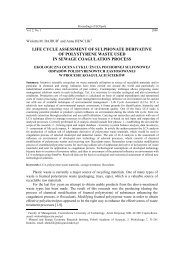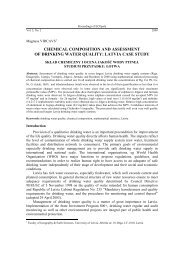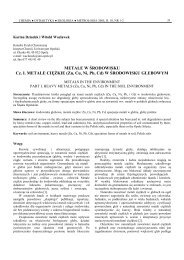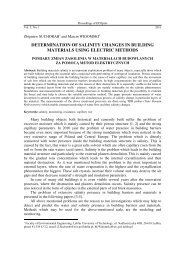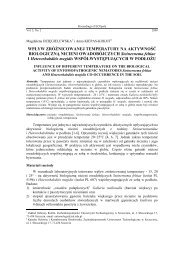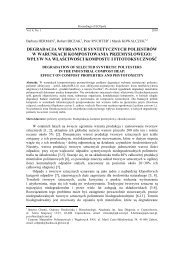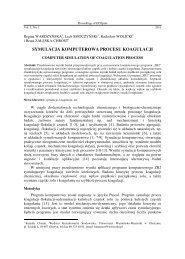318 Wojciech Baran, Ewa Adamek, Justyna Ziemiańska, Andrzej Makowski i Andrzej Sobczak determined against <strong>the</strong>se strains to sulfanilamide and sulfamethoxazole were 15 µmol dm –3 (Microbacterium spp.) and 19 µmol dm –3 (C. freudii), respectively. Additionally, it was found that <strong>the</strong> resultant inhibitory effect on <strong>the</strong> growth <strong>of</strong> tested microorganisms decreased during <strong>the</strong> AOP, but it was much slower than accompanying degradation <strong>of</strong> sulfonamides. The strongest effect was observed with microorganisms more sensitive to sulfonamides. However, in a few cases it was observed <strong>the</strong> increase in <strong>the</strong> inhibition during <strong>the</strong> AOP. Keywords: sulfonamides, ecotoxicity, advanced oxidation processes
Proceedings <strong>of</strong> ECOpole DOI: 10.2429/proc.2012.6(1)044 2012;6(1) Jarosław GAWDZIK 1 i Jolanta LATOSIŃSKA 1 ANALIZA MOBILNOŚCI METALI CIĘŻKICH W WYBRANYCH OSADACH ŚCIEKOWYCH Z OCZYSZCZALNI ŚCIEKÓW O RÓŻNEJ PRZEPUSTOWOŚCI ANALYSIS OF HEAVY METALS MOBILITY IN MUNICIPAL SEWAGE SLUDGE FROM DIFFERENT CAPACITY SEWAGE TREATMENT PLANTS Abstrakt: W artykule przedstawiono wyniki badań nad mobilnością metali ciężkich. Metodologia zastosowana w pracy została zaproponowana przez Community Bureau <strong>of</strong> Reference (BCR). Dostarczone do badań osady ściekowe pochodziły z pięciu komunalnych oczyszczalni ścieków z Polski centralnej. Oczyszczalnie różniły się zarówno wielkością (RLM), jak i sposobem stabilizacji osadów ściekowych. Wykazano, że metale ciężkie były obecne głównie we frakcjach niemobilnych, które nie mają istotnego znaczenia w aspekcie toksykologicznym. Wykazano wpływ wielkości oczyszczalni ścieków na formy występowania metali ciężkich. Postawiono hipotezę, że formy miedzi w osadach ściekowych są charakterystyczne dla tego metalu. Uzyskana metodą ekstrakcji sekwencyjnej (BCR) osadów ściekowych zawartość cynku, ołowiu, kadmu, niklu i chromu nie zależała w sposób jednoznaczny od sposobu stabilizacji osadów ściekowych. Słowa kluczowe: osady ściekowe, metale ciężkie, ekstrakcja sekwencyjna, mobilność metali ciężkich Osady ściekowe powstające w oczyszczalniach ścieków mają cenne wartości nawozowe i mogą być używane w rolnictwie pod warunkiem, że zawartość mikrozanieczyszczeń nie wywoła negatywnych skutków w środowisku glebowym [1-3]. Wysoka zawartość metali ciężkich w osadach ściekowych może mieć związek ze znaczącym udziałem ścieków przemysłowych (np.: garbarskich, lakierniczych, hutniczych) w ogólnej masie ścieków miejskich. Ponadto metale ciężkie pochodzą ze spływów powierzchniowych oraz występują w ściekach w następstwie korozji przewodów kanalizacyjnych. Metale ciężkie w ściekach występują w formie zawiesin oraz w postaci rozpuszczonej. Procesy oczyszczania ścieków, w tym proces defosfatacji, a także procesy strącania chemicznego wapnem, prowadzą do kumulacji metali ciężkich w osadach oraz ich usunięcia ze ścieków [4-6]. Również procesy bioakumulacji masy przez mikroorganizmy w komorach osadu czynnego oraz proces fermentacji metanowej (utworzenie niemobilnych siarczków metali ciężkich) sprzyjają transferowi metali ciężkich ze ścieków do osadów [3]. W osadach ściekowych metale ciężkie występują w postaci rozpuszczonej, wytrąconej, współstrąconej z tlenkami metali, zaadsorbowane lub zasocjowane na cząstkach resztek biologicznych [1]. Mogą mieć formę tlenków, wodorotlenków, siarczków, siarczanów, fosforanów, krzemianów, organicznych połączeń w postaci kompleksów huminowych oraz związków z cukrami złożonymi [6]. Powyższe przemiany wpływają na zróżnicowanie form chemicznych metali ciężkich skumulowanych w osadach ściekowych, z których jednak część (formy mobilne) może przenikać z osadów do środowiska gruntowego [7]. Obowiązujące przepisy prawa w Polsce, określające maksymalne zawartości metali ciężkich w komunalnych osadach ściekowych stosowanych do celów rolniczych (DzU Nr 1 Katedra Inżynierii i Ochrony Środowiska, Politechnika Świętokrzyska, al. Tysiąclecia Państwa Polskiego 7, 25-314 Kielce, tel. 41 342 45 71, fax 41 342 45 27, email: jgawdzik@tu.kielce.pl, jlatosin@tu.kielce.pl



